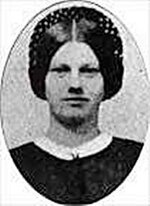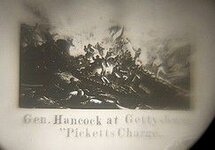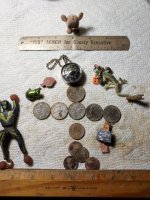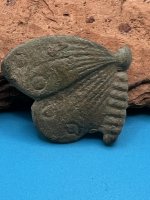So, I'm talking with my supervisor about my hobby and he tells me that his grandfather left behing a whole bunch of odds and ends(collectibles) that he's(my supervisor) has been luggin around for years now. He's gotten rid of a few things here and there, but still has some stuff. So I tell him to bring in whatever he has questions about and if I don't know I can get some answers here on T-Net  He brings me this bullet, 58 cal Union bullet(common variety) but it has a small hole in it in the middle(from the side) that has what looks like a glass bead poking through on the other side. It's also been made into a pendant with a small clasp going through the conical point. I don't have a pic of it yet, but will be posting that in the near future.
He brings me this bullet, 58 cal Union bullet(common variety) but it has a small hole in it in the middle(from the side) that has what looks like a glass bead poking through on the other side. It's also been made into a pendant with a small clasp going through the conical point. I don't have a pic of it yet, but will be posting that in the near future.
So, anyway, my supervisor let me hold onto it for a few hours and after a while my curiosity got me. I picked it up and looked through the bead with a ceiling light in the background. Sure enough, the bead held an image in it. I told my supervisor and he retrieved it and said he was gonna do some research on it when he got home. He said that when he got home he handed it to his wife and asked her what she could see in the bead(he has poor eyesight). She said she could see the name "Geenie Wade" and 2 pics, one of a woman and the other of a house scene. He googled Geenie Wade and found out that she was a nurse killed by a stray bullet during the Civil War in Gettysburg. This sparked a few questions and so he called a friend of his in Virginia who told him the rest of the story.
There was a man living in Gettysburg during the Civil War named C. A. Blocher who crafted what are known as Stanhope Bullets(which is what I think my supervisor's bullet is). He, like hundreds of other scavengers, wanted to turn a profit right after the Gettysburg battle, selling souviniers. He was a jeweler, and the majority of relics he used were bullets. While the majority of the Stanhope bullets have famous generals, he also commemerated other lesser known individuals who participated in that particular battle. The story retrieved by my supervisor is that a stray bullet travelled through 2 doors when it struck and killed Geenie Wade(you can google her story as well).
Before I post this, my supervisor also promised to bring in a musket w/bayonet, and a buckle. I will take pics of all 3 items and will use them to update this post. I may not be finding these items at this time, but it is a pleasure for me when I can help someone else ID something they have.
Note: He was ready to "give" me the bullet before I pointed out that the bead had an image, but I am not too disappointed as I was able to learn a little history myself. Besides, just coming within close proximity of something that has been involved in a famous event such as the Battle of Gettysburg is indeed a privilege.
 He brings me this bullet, 58 cal Union bullet(common variety) but it has a small hole in it in the middle(from the side) that has what looks like a glass bead poking through on the other side. It's also been made into a pendant with a small clasp going through the conical point. I don't have a pic of it yet, but will be posting that in the near future.
He brings me this bullet, 58 cal Union bullet(common variety) but it has a small hole in it in the middle(from the side) that has what looks like a glass bead poking through on the other side. It's also been made into a pendant with a small clasp going through the conical point. I don't have a pic of it yet, but will be posting that in the near future.So, anyway, my supervisor let me hold onto it for a few hours and after a while my curiosity got me. I picked it up and looked through the bead with a ceiling light in the background. Sure enough, the bead held an image in it. I told my supervisor and he retrieved it and said he was gonna do some research on it when he got home. He said that when he got home he handed it to his wife and asked her what she could see in the bead(he has poor eyesight). She said she could see the name "Geenie Wade" and 2 pics, one of a woman and the other of a house scene. He googled Geenie Wade and found out that she was a nurse killed by a stray bullet during the Civil War in Gettysburg. This sparked a few questions and so he called a friend of his in Virginia who told him the rest of the story.
There was a man living in Gettysburg during the Civil War named C. A. Blocher who crafted what are known as Stanhope Bullets(which is what I think my supervisor's bullet is). He, like hundreds of other scavengers, wanted to turn a profit right after the Gettysburg battle, selling souviniers. He was a jeweler, and the majority of relics he used were bullets. While the majority of the Stanhope bullets have famous generals, he also commemerated other lesser known individuals who participated in that particular battle. The story retrieved by my supervisor is that a stray bullet travelled through 2 doors when it struck and killed Geenie Wade(you can google her story as well).
Before I post this, my supervisor also promised to bring in a musket w/bayonet, and a buckle. I will take pics of all 3 items and will use them to update this post. I may not be finding these items at this time, but it is a pleasure for me when I can help someone else ID something they have.
Note: He was ready to "give" me the bullet before I pointed out that the bead had an image, but I am not too disappointed as I was able to learn a little history myself. Besides, just coming within close proximity of something that has been involved in a famous event such as the Battle of Gettysburg is indeed a privilege.
Upvote
0





 Can't wait to see some pics.
Can't wait to see some pics.



